McIver's Women's Baths, CoogeeThe McIver's Women's Baths, sometimes known as the McIver's Ladies Baths, are beautiful ocean swimming baths located in cliff face on the southern headland of Coogee Beach and are, like nearby Wylie's Baths, an important heritage site. Not just a heritage site, but an important recreational facility and many consider it one of the coolest places to visit in Coogee.
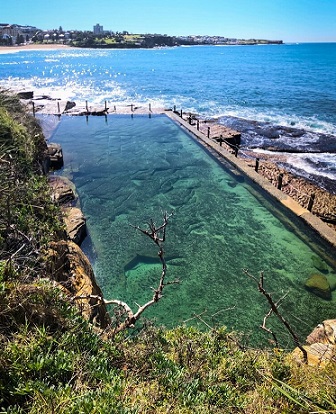
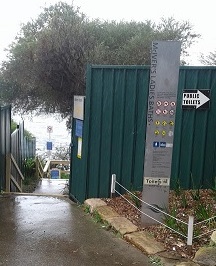
McIver's Women's Baths Entrance Just $2.50 entrance
The McIver's Baths, is also a unique institution in Australia. It is the sole public women's-only swimming baths in Australia and the only place or institution in New South Wales to which the State's Anti-Discrimination Board has given a Women's Only status. These ocean-side sea baths have been intimately associated with the growth of women's sport in Australia including the development of early Australian Olympic swimming champions and the amateur swimming movement.
Social Pressure against Women's Sport Even though the prohibition on public bathing was abolished in 1902 after campaigns of public agitation against the bans (especially at Bondi and Manly), many people saw it as providing permission for only men to swim openly in daylight hours. Socially, many people still did not consider it proper for women to bathe openly in the sea. If they did, there was considerable pressure, including from the popular press, for women to continue to bathe in segregated areas of beaches. Indeed, the prominent pioneering feminist Rose Scott resigned as President of the New South Wales Amateur Swimming Association after a very public dispute with the future Olympian and Coogee Ladies Baths attendee, Fanny Durack. Rose Scott and her supporters felt it was improper for women to compete in swimming carnivals in the presence of men and felt that Fanny Durack should not compete in the 1912 Olympic Games where men would be present. Ultimately, Fanny Durack competed and won an Olympic medal. However, the incident does highlight the pressure upon women to conduct themselves with greater decorum than expected of men.
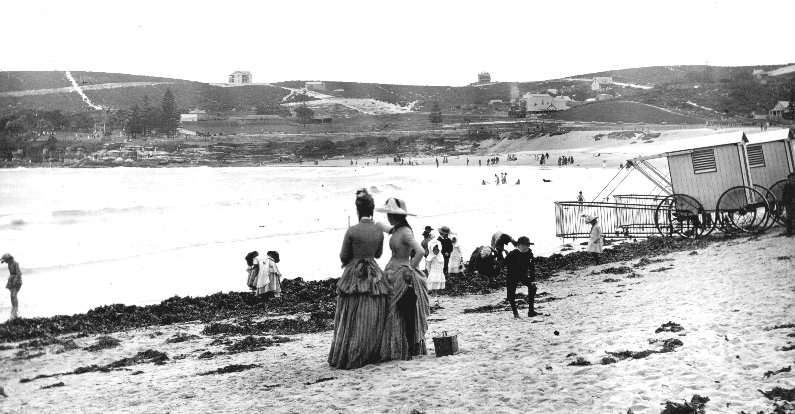 Bathing at Coogee in 1895 As always, there was debate within society about what represented respectability and normal behaviour. The Melbourne Punch in January 1919 carried a centre double page photographic essay titled Spending the Sabbath: the Beach or the Kirk. On the left hand page were photographs of people, including groups of women, in swimming costumes at the beach, and other groups recreating in parks, and of a couple caressing in a garden. On the right hand side were photographs of people dressed formally and with stern and serious expressions leaving a church service. You could imply that respectability lay with religious observance, or you could imply that the fashionable went to the beach and the old fashioned went to Church. Such a debate, however, would militate against some people using public recreational facilities.
Segregation There was therefore a continuing need for somewhere for women to swim. The baths continued to be a place where women's sport and recreation was encouraged from then until the present day.
Long History Press reports show that by the late 1870s the rock pool (or rock pools) at the southern end of the beach (roughly where the pool is located today) was generally considered to be the women's only swimming location, while the rock pool at the northern end of the beach (where Giles Baths are today) were considered the men's swimming location. As groups of people arrived at the beach, the men tended to peel off to the left and headed towards north, while the women peeled off to the right and headed south to the ladies baths. Respectable society generally approved of this segregation, but now and then, some complained that young men and women tended to drift off from their allotted areas and coalesce towards the centre of the beach.
Segregated Swimming Unsafe
Edith Kidman Tragedy of 1879 Edith Kidman's death was felt keenly in the local community; a young girl from a well known and prominent local family. Her parents were Charles (1822 - 1885) and Sarah Kidman nee Cook (1831-1886). Charles was an Alderman on the first Randwick Council in 1859, and an Alderman on Sydney City Council with extensive business interests. Kidman Street, Coogee is named after him.
Viles Sisters Tragedy, 1883 This particular morning, there was a heavy swell with a big surf. Young Ida "divested herself of her clothes" and ran towards a rock ready to dive into the pool when a large wave crashed down on her and the undertow dragged her into the open surf. Neither of the Viles girls could swim, and this was only the second time they had undertaken this early morning adventure. Distressed, the older sister jumped into the surf in an attempt to save her sister, but both were engulfed by the heavy sea. Julia Lowe, who had been on the tram with the Viles', managed to grab hold of Blanche's hand, but then the younger sister grabbed onto Blanche, and the weight was too much for Miss Lowe. Both were swept into the swelling surf again. Down on the southern side of the beach, below where the surf club is now, stronger swimmers were surfing, but could hear the commotion from "over the hill and got out of the water to investigate. Seeing women frantically waving from the hill to the south, they ran to help. However, it took some minutes to reach the ladies pool, and by then the Viles sisters had disappeared. Senior-constable Andrew Strachan and Constable Rodgers from Randwick police station, on hearing news of the drowning, came down Coogee Bay Road, and found a sombre crowd gathered by the pool. They spotted one of the bodies of the two girls floating in the water between the shore and Wedding Cake Island. With a local man, George Donnelly, they went over to Thompson's Bay (now Gordon's Bay) and took a boat around to Coogee and retrieved the body of young Ida at about 10am. They kept searching and at about 2pm, found the body of Blanche, fully-clothed and floating near the shore. As was the practice in those days, they conveyed their bodies to their home in Botany Street, Randwick.
Rock Pools Unsafe - Need for Formal Baths At some stage after the drowning of the Viles sisters, likely in 1896, the pool was enclosed by a concrete wall and what had just been rock pools were transformed into a dedicated baths for women. The Council leased the operation of the baths to private operators. An early leasee was Henry Alexander Wylie, a champion long distance and underwater swimmer. He seems to have relinquished the lease of the baths in the early 1900s in favour of George and Maude Bassett and then the McIver family. Henry Wylie may have seemed to have been an unlikely holder of the lease to a women's baths, but to give Whylie his due, he always seemed to be one to promote the sporting abilities of women. In 1907 Wylie also established the adjacent Wylies Baths, a mixed bathing establishment. Wylie's daughter was Wilhelmina (Mina) Wylie, (1891 - 1984) and with Fanny Durack (1889 - 1956) were Australia's first two female Olympic swimming representatives who competed in the Stockholm Olympics of 1912. They provided Australia with its first triumphs in Olympic women's swimming. Fanny won a Gold medal and Mina a Silver medal at the Games. From fourteen years of age Mina was practically unbeatable. She competed in NSW and Australian championships from 1906 to 1934 winning 115 NSW and Australian titles. You can read more about Mina Wylie here.
McIver Family
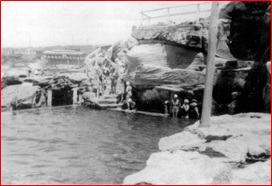
McIver's Baths, Coogee, c. 1930s Mysterious Disappearance of Mrs Maud Bassett Coogee and the Sydney region witnessed very wild weather and storms on July 19 1910, many claiming the storms to be the worst ever witnessed at Coogee. The Blue Mountains recorded record heavy snowfalls. Mr. George Bassett, the caretaker of the baths at the time, stepped out of his residence at the baths in the morning to check on storm damage - some parts of the baths' walls had been swept away. When he returned a few minutes later, he says he could not locate his wife, Mrs. Maud Bassett, aged 29. He searched the residence, nearby areas and enquired of neighbours without locating her. Bassett said that when he had left his wife, she had been dressed for the house and not wearing any suitable outdoor clothing. She had mysteriously disappeared, never to be seen again. Bassett feared that his wife had gone outdoors for some reason and had been swept off the cliffs by the gale weather. Police were informed and a long search was undertaken. Even a month later, the press was reporting that there had been no sign of Mrs Bassett or what became of her. Tragically, it appears that the Bassetts were newly weds: according to the New South Wales Births, Deaths & Marriages online historical database, they were only married in that year.
The Fire of 1930 Despite the heavy damage, the baths opened for business the following morning and many women were swimming in the baths. Unfortunately, another fire, a deliberately lit, in the Clubhouse in 1970 destroys many of the clubs records and memorabilia stored there. Another fire in the rebuilt Clubhouse in 1982, caused more damage.
Anti-Discrimination Case of 1994 Of course, discrimination was hardly an issue. The baths occupy a relatively tiny part of the coastline and do not really deny anyone access to the vast majority of the local coastline. There are equal, if not much superior, facilities close-by which everyone can enjoy. It would be safe to say that the baths, under their current status, enjoy wide Coogee public support from all locals.
Need for Women's Baths
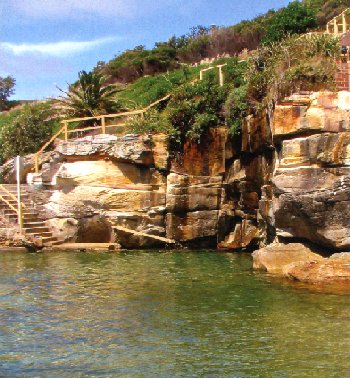
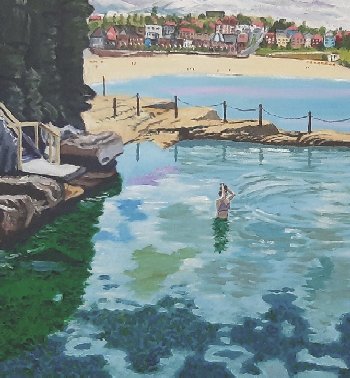 McIver's Women's Baths, 2017
References Copyright © Coogee Media. All rights reserved
|